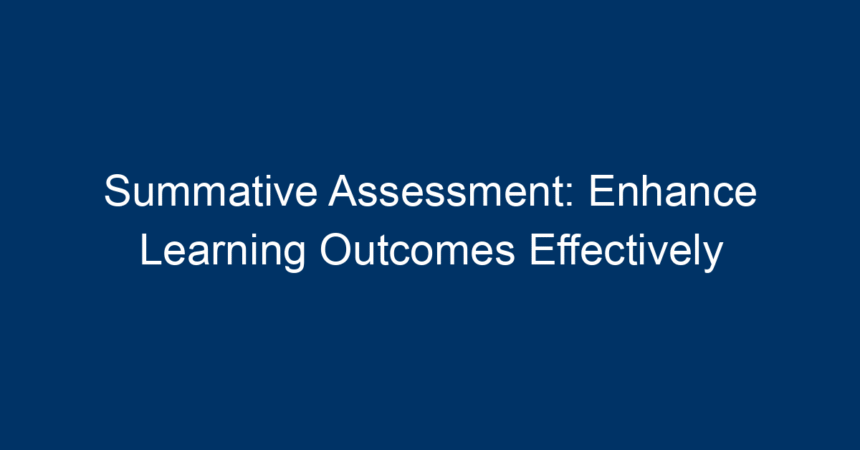In the dynamic landscape of education, assessment methods play a pivotal role in measuring student progress and shaping teaching strategies. Among these methods, summative assessment stands out as a powerful tool for educators. By providing valuable insights into student learning, summative assessments help inform instruction, identify gaps, and enhance overall learning outcomes. Let’s explore what summative assessment is, its impact on education, and how educators can effectively implement strategies to maximize its benefits.
What Is Summative Assessment?
Summative assessment is designed to evaluate student learning at the conclusion of an instructional unit by comparing it against a standard or benchmark. Unlike formative assessments (which are conducted during the learning process to modify teaching and learning activities), summative assessments typically occur at the end of a term, course, or program. They often take the form of final exams, standardized tests, projects, or portfolios.
Key Characteristics of Summative Assessment
-
Final Evaluation: Summative assessments provide a comprehensive overview of what students have learned and how well they can apply that knowledge.
-
High Stakes: Because they often carry significant weight in determining grades or graduation status, these assessments can have a profound impact on students’ academic futures.
-
Structured Format: Summative assessments are usually standardized, ensuring that all students are evaluated against the same criteria.
- Feedback for Improvement: While they primarily focus on evaluating outcomes, summative assessments can also serve as a feedback tool to inform future teaching strategies.
The Importance of Summative Assessment in Education
Measuring Learning Outcomes
Summative assessment provides a clear picture of student achievement and learning outcomes. By analyzing the results, educators can understand how well students have grasped the material and identify areas that may require further attention.
Informing Curriculum Development
The data collected from summative assessments can inform curriculum design and instruction methods. If a large number of students perform poorly on a specific topic, educators can reassess their teaching approach to address the content gaps.
Enhancing Accountability
By implementing summative assessments, schools can demonstrate accountability to stakeholders, including parents, school boards, and accrediting organizations. These assessments provide quantifiable data that can reinforce the effectiveness of educational programs.
Supporting Student Reflection
When students receive their results from summative assessments, it provides them with an opportunity to reflect on their learning journey. Understanding where they excelled or fell short can motivate them to take ownership of their learning and set goals for future improvement.
Best Practices for Implementing Summative Assessment
Align Assessment with Learning Objectives
To enhance learning outcomes effectively, it is crucial to align summative assessments with the intended learning objectives. This ensures that the assessment accurately measures what students are supposed to learn.
-
Define Clear Learning Goals: Establish specific, measurable goals that you want your students to achieve.
- Develop Assessment Criteria: Craft rubrics and success criteria that guide students in understanding the expectations associated with the summative assessment.
Utilize Diverse Assessment Methods
Different students exhibit unique strengths and weaknesses. A variety of assessment techniques can cater to these differences and provide a comprehensive understanding of student learning.
-
Traditional Exams: Multiple-choice, short answer, and essay questions can evaluate knowledge recall and critical thinking.
-
Projects and Presentations: Allow students to demonstrate their understanding in creative ways that align with real-world applications.
- Portfolios: Compile a range of student work over time to showcase growth and development.
Provide Timely Feedback
Receiving feedback can be invaluable for student growth. While summative assessment typically happens at the end of a unit, providing feedback in a timely manner is still essential.
-
Use the Results for Reflection: Give students the chance to review their assessments and understand where they went wrong, along with strategies for improvement in future assessments.
- Communicate with Parents: Sharing insights with parents can help them understand their child’s performance and how they can best support their learning.
Foster a Growth Mindset
Encouraging a growth mindset among students can transform the approach to summative assessments. Emphasize that assessments are not just a measure of ability but an opportunity for growth and learning.
-
Celebrate Effort and Progress: Acknowledging improvements and hard work can motivate students to view assessments as a learning opportunity rather than a final judgment of their abilities.
- Encourage Goal Setting: After assessments, have students set goals based on their performance, promoting a proactive approach to future learning.
Common Challenges in Summative Assessment
While summative assessments provide many benefits, there are challenges that educators must be aware of.
Test Anxiety
Many students experience anxiety during high-stakes assessments, potentially impacting their performance. Educators should create a supportive environment that minimizes stress and encourages a relaxed mindset.
Overemphasis on Grades
Relying too heavily on grades can detract from the true purpose of summative assessments: to enhance learning outcomes. Shift the focus from just grades to the learning process itself.
Diverse Learning Styles
Each student learns differently, which can make it challenging to create a one-size-fits-all assessment. Be mindful of accommodating diverse learning styles to ensure that all students can demonstrate their understanding effectively.
Conclusion: Actionable Insights for Effective Summative Assessment
Incorporating summative assessment into the educational framework can significantly enhance learning outcomes if implemented thoughtfully. Here are some actionable insights:
-
Align assessments with learning objectives to ensure they measure what students are intended to learn.
-
Diverse assessment methods can cater to various learning styles and abilities, providing a broader picture of student achievement.
-
Timely feedback is crucial for student reflection and growth; use results to motivate and inform future learning paths.
- Promote a growth mindset among students, emphasizing that assessments are part of the learning journey, not the end of it.
By addressing the challenges and leveraging effective strategies, educators can ensure that summative assessments serve their true purpose: enhancing learning and fostering a deeper understanding among students. Let’s embrace summative assessments as vital tools in the quest for educational excellence!




